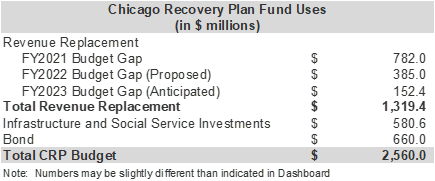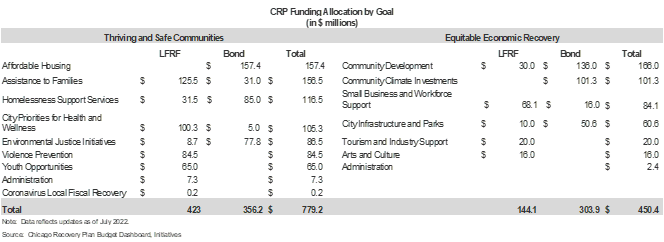August 26, 2022
As part of the American Rescue Plan Act’s (ARPA’s) $350 million federal investment into Fiscal Recovery Funds at the state and local levels, the City of Chicago received a $1.9 billion infusion under the Local Fiscal Recovery Fund (LFRF) to mitigate the effects of the COVID-19 pandemic.[1] In compliance with Treasury Department guidelines, the City developed and released in September 2021 a comprehensive plan to “create an equity-based investment strategy to catalyze a sustainable economic recovery,” dubbed the Chicago Recovery Plan (CRP), for use in Fiscal Years 2022 through 2026.[2]
The U.S. Department of Treasury requires that the City post their recovery plan on a public-facing webpage, and which can be accessed through the Chicago Recovery Plan Dashboard. Further Treasury Department guidelines state that the City is required to submit several types of reports, as a large metropolitan area. The first was a one-time Interim Report breaking down funding status and uses, which was due by August 31, 2021 or 60 days after receiving funding. The City must also submit Project and Expenditure Reports, the first of which was due January 31, 2022 and thereafter the last day of the month following each quarter’s end, outlining contracts, projects, expenditures and subawards over $50,000. Lastly, a Performance Report is due every July 31 that details funded projects and the plan to achieve specified goals (identified by the Treasury Department and award recipients within those projects).[3] The most recent CRP Performance Report, which is the only of the three with specific instructions for public posting, was released July 31, 2022.
As seen in the table below, CRP is funded through a combination of the $1.9 billion in LFRF funding and a proposed $660 billion general obligation bond, accounting for a total budget of approximately $2.56 billion. The City received the first half of LFRF funding in May 2021, and the second half twelve months later. Of the LFRF Funding, approximately $1.32 billion will be allocated towards revenue replacement for budget deficits from FY2021 through FY2023, labeled as “Essential City Services” in reporting to the federal government and the City’s own budget documents. The Recovery Plan utilized $782 million to close the FY2021 budget gap, $385 million was proposed to close the FY2022 budget gap, and $152.4 million is expected to be used to address part of the projected budget gap for FY2023, as outlined in the recently-released 2023 Budget Forecast. The remaining $580.6 million will be used in combination with $660 million in general obligation bond funding (which has not yet been issued) to dedicate to specific initiatives that the City says will address urgent needs for its residents.[4] These combined funds will therefore provide a total of $1.24 billion in funding for non-revenue replacement LFRF and Bond Initiatives.[5]

The investment in LFRF and Bond Initiatives will be split across two strategic themes the City says were determined through engagement with community leaders through a series of meetings, roundtables, and focus groups. As shown in the table below, this includes a $779.2 million investment in Thriving and Safe Communities – aimed at social and community support investments to combat the root causes of community violence. This includes investments in public health services, financial support to families, increased educational opportunity, housing support, and violence reduction.[6] Programs aimed at affordable housing and assistance to families show the highest investments at $157.4 million and $156.5 million, respectively, followed by City Priorities for Health and Wellness at $105.3 million.
The second strategic investment theme of Equitable Economic Recovery will direct neighborhood development funding to communities that were most impacted by the pandemic through investments geared at spurring economic recovery. This funding will consist of long-term infrastructure, workforce, and arts and cultural investments to support disadvantaged communities. The total $450.4 million investment includes a $166 million investment in Community Development, $101.3 million in Community Climate Investments, $84.1 million in Small Business and Workforce Supports, among others. The specific initiatives from each of the themes can be found on the Chicago Recovery Plan Dashboard and in the City’s Recovery Plan Performance Report.

The Dashboard provides periodic updates on the progress of fund allocations and other initiatives. The most recent updates, as of July 2022, show that $869 million of the total budget has been obligated or paid, which includes the $782 million to close the FY2021 budget gap. An additional $317 million are in the RFP phase or have applications released. Approximately 53.4%, or $1.361 billion, remain in progress and reserved for future years. No further expenditure details have been provided to date. The Dashboard also notes pending updates, which will include initiative status updates, outcome and KPI reporting, obligation and expenditure data by priority and initiative, and delegate expenditure reporting. For more information about the City’s expenditures to date and those of other governments, visit the United States Department of Treasury’s webpage dedicated to ARPA SLFRF reporting and scroll to the bottom of the page.
The Civic Federation will continue to monitor the progress on funding initiatives within the CRP and will provide updates as they become available.
Related Links:
Chicago Recovery Plan Overview
[1] Chicago Recovery Plan, p. 4.
[2] Chicago Recovery Plan Dashboard, Introduction.
[3] Compliance and Reporting Guidelines: State and Local Fiscal Recovery Funds, U.S. Department of Treasury, August 15, 2022, pp. 14-15.
[4] Chicago Recovery Plan Dashboard, Introduction.
[5] City of Chicago FY2022 Budget.
[6] Chicago Recovery Plan, p. 5.
